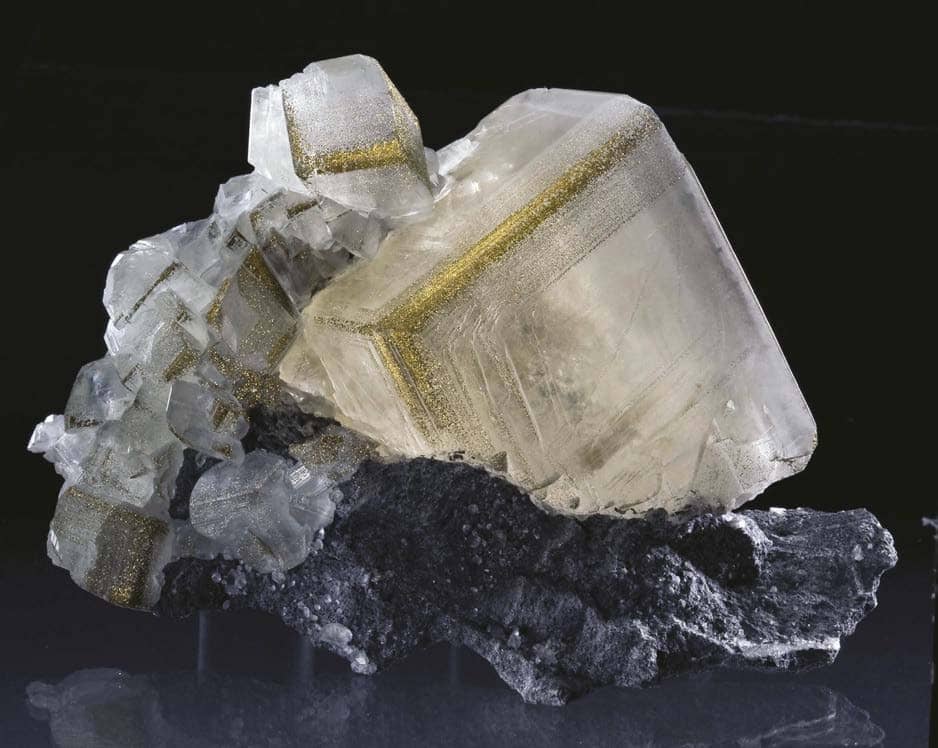Essayer OR - Gratuit
Crystal Habits
Rock&Gem Magazine
|July 2020
Whenever we talk about minerals, especially our favorite minerals, we use all sorts of descriptive terms that don’t seem to have anything to do with one of the six crystal systems.

Mineral specimens are commonly described as dendritic, acicular, columnar, striated, botryoidal, banded, and prismatic, acicular.
These terms are the language of crystal habits and are an integral part of a conversation when we describe mineral specimens. While using such terms, we seldom think about why a particular term works for us. I doubt we realize these terms are the direct result of two things, the mineral’s internal atomic structure and the role it plays in a mineral’s development and the effects of the environment on a mineral during formation. We already know when a mineral forms, it develops as one of the recognized crystal systems: isometric, hexagonal, monoclinic, triclinic, tetragonal, or orthorhombic. You may also come across a seventh system, trigonal. This is actually a sub-system based on two basic crystal forms in the hexagonal system.
Regular calcite can show an obvious hexagonal form while some calcites develop in rhombic crystals, so they are identified as trigonal crystals. You have undoubtedly seen this in some rhodochrosite specimens, which is another carbonate. This mineral type shows the same two hexagonal systems. When we describe a mineral, we may start by naming its crystal system. But we need to use terms that describe the specimen in far more detail, and that’s when we describe the mineral’s crystal habits. Native copper is an example of this. It is a cubic or isometric mineral.

Cette histoire est tirée de l'édition July 2020 de Rock&Gem Magazine.
Abonnez-vous à Magzter GOLD pour accéder à des milliers d'histoires premium sélectionnées et à plus de 9 000 magazines et journaux.
Déjà abonné ? Se connecter
PLUS D'HISTOIRES DE Rock&Gem Magazine

Rock&Gem Magazine
The Black Prince's Ruby and Other Cursed Gems
Submitted for your consideration: A collection of gems whose acquisition has often been synonymous with terrible loss but whose sparkle still holds fatal attraction. Meet some of the most cursed and feared - gems in history.
7 mins
October 2025

Rock&Gem Magazine
The Minerals of Transylvania
Whether you're in it for science, beauty, spooky stories, or all of it, Transylvania's minerals offer a little something for every rockhound. Deep in the heart of Romania, the Carpathian Mountains are known for gothic lore and vampire legends. In this land of Dracula, Transylvania's rugged geology, shaped by volcanic activity, has made it one of Europe's most mineral-rich areas.
2 mins
October 2025

Rock&Gem Magazine
Is Earth's Magnetic Field Linked to Atmospheric Oxygen?
The scientists making the observation were surprised. A time series analysis of geological records over the past 540 million years of Earth history seems to show a highly correlated link between oxygen levels in the Earth's atmosphere and the strength of the planet's magnetic field, and both seem to be slowly increasing in sync.
1 min
October 2025

Rock&Gem Magazine
The Best Archaeopteryx Yet
Archaeopteryx has been an icon in the world of paleontology ever since the first one was uncovered in 1861.
1 min
October 2025

Rock&Gem Magazine
Ancient Proteins Survive Much Longer than Expected and offer new insights into rhino evolution
In paleontology, the old days of pick-and-shovel and drawing evolutionary relationships based on anatomy alone may not be long gone, but they’re certainly being overshadowed by advances in the lab.
1 min
October 2025

Rock&Gem Magazine
PENNSYLVANIA'S FOSSIL FOREST
Some 300 million years ago, near the town of St. Clair, Pennsylvania, the land was covered by lush green forests with a wide variety of plants and trees.
3 mins
October 2025

Rock&Gem Magazine
From Waste to Rock in No Time Flat!
Ever wonder how long it takes for rock to form? It could be as little as minutes when molten lava hits ice-cold water beneath the sea to instantly form igneous basalt.
1 min
October 2025

Rock&Gem Magazine
Maribel CAVES & HOTEL...
Haunted Ruins With 'New Hope' For Caves
7 mins
October 2025

Rock&Gem Magazine
THE GEOLOGY OF GRAVESTONES
Along with black cats, witches and jack-o'-lanterns, cemeteries are iconic symbols of Halloween—and for good reason. Shrouded in mystery, superstition and folklore, they can elicit feelings of foreboding and fear.
4 mins
October 2025
Rock&Gem Magazine
Is Subduction “Infectious?”
Earth’s surface is composed of huge plates of relatively stable continental crust and oceanic crust that are constantly forming and recycling. Where they meet, subduction frequently occurs, with ocean crust plunging beneath continents. Thus oceans open and close, appear and disappear.
1 min
October 2025
Translate
Change font size
